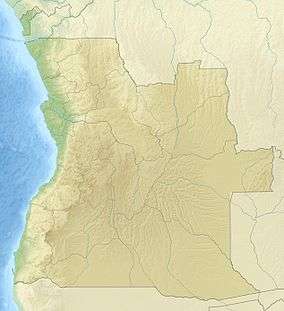Iona National Park
| Iona National Park | |
|---|---|
|
IUCN category II (national park) | |
|
Imbondiero Tree, Iona National Park, Angola | |
 | |
| Location |
|
| Nearest city | Lubango |
| Coordinates | 16°40′S 12°20′E / 16.67°S 12.33°ECoordinates: 16°40′S 12°20′E / 16.67°S 12.33°E |
| Area | 15,200 km2 |
| Established | 1964 |
| Governing body | Ministeria do Ambiente, Angola |
Iona National Park (Portuguese: Parque Nacional do Iona) is the largest national park in Angola. It is situated in the Southwestern-most part of the country, in Namibe Province. It is roughly bounded by the Atlantic Ocean to the West, an escarpment to the East that marks the beginning of the interior plateau, the Curoca River to the North, and the Cunene River to the South. It is about 200 kilometres (120 mi) south of the city of Namibe and covers 5,850 square miles (15,200 km2) sq. miles.[1]
The topography of Iona is characterised by wild dunes, vast plains, and rough mountains and cliffs. Annual average precipitation is approximately 18mmm. The Curoca River is intermittent but has lagoons, while the Cunene is permanent and has marshy areas at its mouth.[2]
Iona had been proclaimed as a reserve in 1937 and upgraded to a national park in 1964. However, as is true for most Angolan national parks, the Angolan Civil War greatly disrupted the area. Illegal poaching and the destruction of infrastructure have caused considerable damage to the once rich park.
In recent years, a number of government and international projects have begun rebuilding the infrastructure of the park.
Geography
Iona is part of the northern Namib Desert, the only true desert in Southern Africa. The area, also known as the Kaokoveld Desert, has been arid for 55-80 million years may be the oldest desert in the world. It faces the Atlantic Ocean for 180 kilometres (110 mi) on the edge of the Benguela Current, a cold up-welling from the depths of the Atlantic that creates a rich ecosystem off-shore. To the east, Iona rises to the base of the Great Escarpment at the Tchamaline and Cafema mountains. Iona is ounded on the north and south by the Cunene and Curoca Rivers, respectively. The climate is noteworthy for the heavy fogs created as the cold, wet air of the Benguela up-welling meets the hot, dry air of the desert. The strong fogs and currents have led to numerous shipwrecks through history. The coast is sometimes called Skeleton Coast after the bones of whales and seals that were seen on the beaches by sailors. The area is classified as a Hot Desert Climate, KWh in the Köppen climate classification.[3]

The park is contiguous with the Skeleton Coast Park in Namibia, which is itself contiguous with the Namib-Naukluft National Park so that all three protected areas form a continuous block covering some 1,200 km of Namib Desert coastline and adjacent dunes.[4]
Vegetation
According to the Angola Ministry of the Environment, there are three types of vegetation at Iona National Park: · Sub-coastal steppes with woody and herbaceous components (Barbosa’s Type 27). This type of vegetation is a sub-coastal African steppe-like formation dominated by Acacia, Commiphora, Colophosphormum, Aristida, Schmidita, and Staria species. · Discontinued coastal steppes (Barbosa’s Type 28), which corresponds to sub-desert-like vegetation. This type of vegetation is dominated by Aristida, Cissus, Salvadora, and Welwitschia species. · Desert with moving dunes (Barbosa’s type 29). This type of vegetation is dominated by Odyssea and Sporobulus species.
The park is the main habitat of Welwitchia Mirabilis, a plant sometimes referred to as a "living fossil". The plant derives its moisture from sea-fog dew[5] which rolls in from the Atlantic. The dew is absorbed through the leaves rather than through roots alone.
Animals
Because of its distinctive habitat and climate, Iona and the Kaokoveld Desert have a number of endemic animals, particularly reptiles. 63 species have been recorded in the ecoregion, eight are strictly endemic. The endemics include two lizards, three geckos, and three skinks.[6] The mouth of the Cunene River to the south supports a small wetland area that is important to migrating birds. South African cheetah have been sighted in the park for the first time in 2010.[7]
Status of ecosystem
Since 2009, a multinational program under the UNDP has been working with the Angola Ministry of Environment and local leaders to rehabilitate the park. Results have been recorded in the training and development of local staff, improvements to park infrastructure (fencing, roads, water supply, waste management, etc.), and the development of sound management for Iona.[8]
Notes
This park is to be included into the Iona - Skeleton Coast Transfrontier Conservation Area.
External links
References
- ↑ "Poaching in Iona is a Crime". Jornal de Angola, March 26, 2012. Retrieved March 17, 2015.
- ↑ "Framework Report on Angola's Biodiversity" (PDF). Republic of Angola, Ministry of Environment, 2009. Retrieved 2015-03-17.
- ↑ "UN Development Program, Iona Conservation Project" (PDF). United Nations Development Programme, Project Document: Conservation of Iona National Park, 2013. Retrieved March 18, 2015.
- ↑ "Birdlife Data Zone". Birdlife Data Zone, Iona National Park, 2013. Retrieved March 18, 2015.
- ↑ "Biodiversity Education and Research Greenhouse: Welwitchia Miribilis". Accession Data, University of Connecticut. Retrieved March 18, 2015.
- ↑ "Deserts and Xeric Shrublands: frica - Coastal Namibia and Angola". Africa: Coastal Namibia and Angola, World Wildlife Fund. Retrieved March 18, 2015.
- ↑ CCF Staff (23 February 2015). "After 30-Year Civil War, Cheetah Presence in Angola Confirmed". cheetah.org Cheetah Conservation Fund. Retrieved 12 July 2015.
- ↑ "National Biodiversity Project: Conservation of Iona National Park". United Nations Development Programme, Project Overview. Retrieved March 18, 2015.
